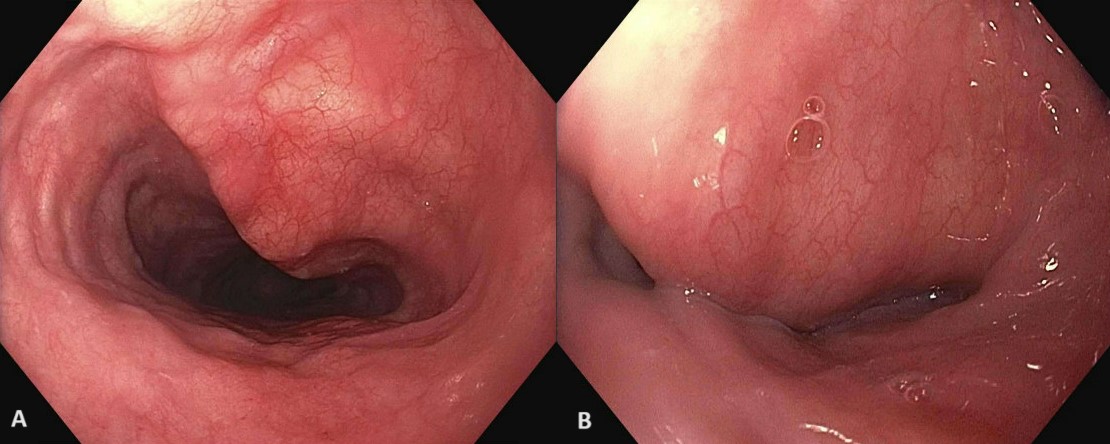Tuesday Poster Session
Category: Esophagus
P4976 - Pulsatile Vessel Causing Esophageal Compression and Dysphagia: A Rare Complication of Anterior Cervical Discectomy and Fusion
Tuesday, October 28, 2025
10:30 AM - 4:00 PM PDT
Location: Exhibit Hall

Obada Daaboul, MD
Southern Illinois University
Springfield, IL
Presenting Author(s)
Obada Daaboul, MD1, Mohammed Martini, MD2, Muhammed Yaman Swied, MBBS1, Muaataz Azzawi, MD1, Ramprasad Jegadeesan, MD3
1Southern Illinois University, Springfield, IL; 2SIU SOM, Springfield, IL; 3Ramprasad Jegadeesan, Cumming, GA
Introduction: Anterior cervical discectomy and fusion (ACDF) is the most common surgical procedure for degenerative cervical spine disease. Potential complications include dysphagia, speech difficulties, and damage to surrounding structures. After ACDF, dysphagia may result from prevertebral soft tissue swelling, extrinsic esophageal compression, nerve injury, inflammation from hardware irritation, or esophageal retraction. We present an interesting and rare case of a post-ACDF patient who developed dysphagia due to extrinsic compression by a displaced, pulsatile vessel, likely secondary to soft tissue swelling.
Case Description/
Methods: A 75-year-old male with a history of cervical radiculopathy presented to the emergency department with dysphagia, a choking sensation, and a feeling of food getting stuck in his chest for the past three weeks following a C3 to T1 ACDF. Computed tomography angiography (CTA) of the chest showed distal esophageal wall thickening without other abnormalities. He underwent esophagogastroduodenoscopy, which showed esophageal narrowing at 20 cm from incisors secondary to extrinsic compression from a pulsating vessel (Figure 1). Given the pulsatile nature of the compression and the proximity of the recent ACDF surgical site to the level of compression, there was suspicion of a displaced vessel externally compressing the esophagus, likely secondary to postoperative soft tissue swelling. Imaging studies obtained prior to surgery and after the onset of symptoms were reviewed with the radiology team, revealing no significant changes that could explain the findings. The final consensus suggested that soft tissue swelling and subtle anatomical displacement, undetectable by CTA, were likely contributing factors. The patient was managed conservatively, and his symptoms resolved spontaneously over the following few weeks, as noted at a clinic follow-up visit.
Discussion: To the best of our knowledge, while dysphagia due to soft tissue swelling is a known complication of ACDF, dysphagia caused by extrinsic esophageal compression from a displaced pulsatile vessel following ACDF is rare and seldom documented. This case aims to raise awareness of a rare but benign cause of postoperative dysphagia following ACDF, to help minimize unnecessary diagnostics and reduce healthcare resource utilization, as symptoms may resolve spontaneously with the resolution of soft tissue swelling.

Figure: Endoscopic images showing a pulsatile vessel compressing the esophagus at 20 cm from the incisors. A: During diastole B: During systole
Disclosures:
Obada Daaboul indicated no relevant financial relationships.
Mohammed Martini indicated no relevant financial relationships.
Muhammed Yaman Swied indicated no relevant financial relationships.
Muaataz Azzawi indicated no relevant financial relationships.
Ramprasad Jegadeesan indicated no relevant financial relationships.
Obada Daaboul, MD1, Mohammed Martini, MD2, Muhammed Yaman Swied, MBBS1, Muaataz Azzawi, MD1, Ramprasad Jegadeesan, MD3. P4976 - Pulsatile Vessel Causing Esophageal Compression and Dysphagia: A Rare Complication of Anterior Cervical Discectomy and Fusion, ACG 2025 Annual Scientific Meeting Abstracts. Phoenix, AZ: American College of Gastroenterology.
1Southern Illinois University, Springfield, IL; 2SIU SOM, Springfield, IL; 3Ramprasad Jegadeesan, Cumming, GA
Introduction: Anterior cervical discectomy and fusion (ACDF) is the most common surgical procedure for degenerative cervical spine disease. Potential complications include dysphagia, speech difficulties, and damage to surrounding structures. After ACDF, dysphagia may result from prevertebral soft tissue swelling, extrinsic esophageal compression, nerve injury, inflammation from hardware irritation, or esophageal retraction. We present an interesting and rare case of a post-ACDF patient who developed dysphagia due to extrinsic compression by a displaced, pulsatile vessel, likely secondary to soft tissue swelling.
Case Description/
Methods: A 75-year-old male with a history of cervical radiculopathy presented to the emergency department with dysphagia, a choking sensation, and a feeling of food getting stuck in his chest for the past three weeks following a C3 to T1 ACDF. Computed tomography angiography (CTA) of the chest showed distal esophageal wall thickening without other abnormalities. He underwent esophagogastroduodenoscopy, which showed esophageal narrowing at 20 cm from incisors secondary to extrinsic compression from a pulsating vessel (Figure 1). Given the pulsatile nature of the compression and the proximity of the recent ACDF surgical site to the level of compression, there was suspicion of a displaced vessel externally compressing the esophagus, likely secondary to postoperative soft tissue swelling. Imaging studies obtained prior to surgery and after the onset of symptoms were reviewed with the radiology team, revealing no significant changes that could explain the findings. The final consensus suggested that soft tissue swelling and subtle anatomical displacement, undetectable by CTA, were likely contributing factors. The patient was managed conservatively, and his symptoms resolved spontaneously over the following few weeks, as noted at a clinic follow-up visit.
Discussion: To the best of our knowledge, while dysphagia due to soft tissue swelling is a known complication of ACDF, dysphagia caused by extrinsic esophageal compression from a displaced pulsatile vessel following ACDF is rare and seldom documented. This case aims to raise awareness of a rare but benign cause of postoperative dysphagia following ACDF, to help minimize unnecessary diagnostics and reduce healthcare resource utilization, as symptoms may resolve spontaneously with the resolution of soft tissue swelling.

Figure: Endoscopic images showing a pulsatile vessel compressing the esophagus at 20 cm from the incisors. A: During diastole B: During systole
Disclosures:
Obada Daaboul indicated no relevant financial relationships.
Mohammed Martini indicated no relevant financial relationships.
Muhammed Yaman Swied indicated no relevant financial relationships.
Muaataz Azzawi indicated no relevant financial relationships.
Ramprasad Jegadeesan indicated no relevant financial relationships.
Obada Daaboul, MD1, Mohammed Martini, MD2, Muhammed Yaman Swied, MBBS1, Muaataz Azzawi, MD1, Ramprasad Jegadeesan, MD3. P4976 - Pulsatile Vessel Causing Esophageal Compression and Dysphagia: A Rare Complication of Anterior Cervical Discectomy and Fusion, ACG 2025 Annual Scientific Meeting Abstracts. Phoenix, AZ: American College of Gastroenterology.
